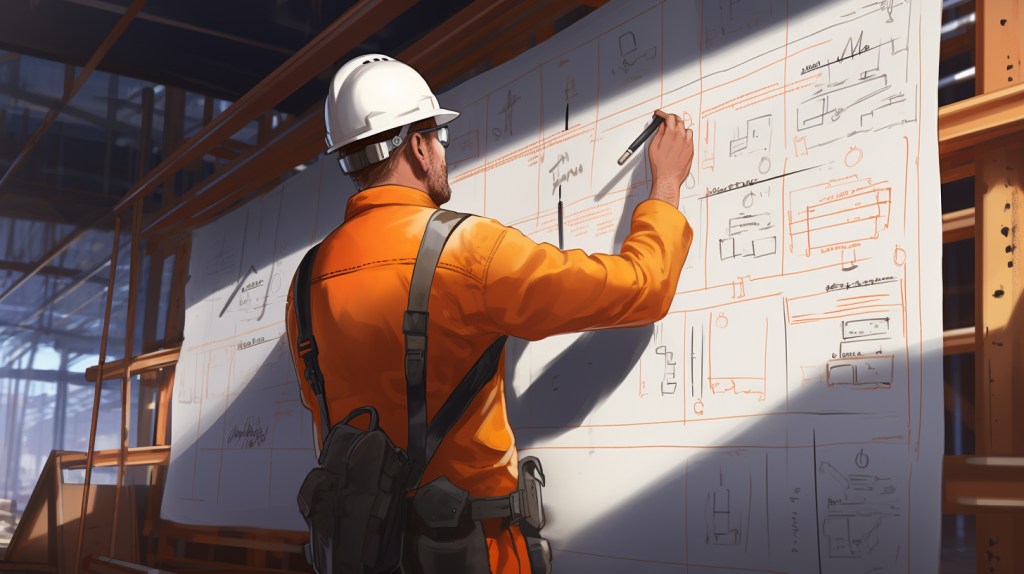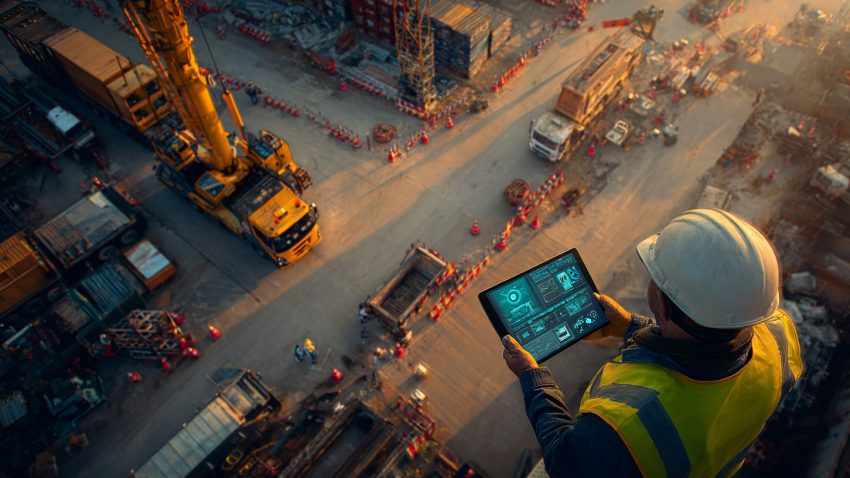The Best Daily, Weekly, and Monthly Checklist for Construction Superintendents
Table of Contents:

Being a construction superintendent is no easy task. It requires a unique blend of organization, coordination, and problem-solving skills to ensure that every aspect of a construction project runs smoothly. From managing contractors and overseeing safety protocols to updating schedules and reviewing project documentation, construction superintendents have a wide range of responsibilities. In this comprehensive checklist, we’ll explore the daily, weekly, and monthly tasks that construction superintendents should prioritize to ensure successful project completion.
Daily Tasks for Construction Superintendents
Review and Update Contractor Reports
Each day, construction superintendents should review and update contractor reports to track progress, identify potential issues, and maintain clear communication with the project team. These reports serve as a valuable resource for documenting daily activities, such as the number of workers on-site, materials delivered, and work completed. Keeping these reports up-to-date helps superintendents stay informed and make informed decisions.
Update Progress on Spreadsheets and Drawings
To keep everyone informed about the project’s status, construction superintendents should regularly update progress on spreadsheets and drawings. By accurately reflecting the advancements made by different trades, superintendents ensure that the project stays on track and any delays or issues are promptly addressed. This practice also helps maintain transparency with stakeholders.
Maintain Rate of Change Spreadsheets
Change is inevitable in construction projects. Superintendents must maintain rate of change spreadsheets to document any modifications or variations that occur throughout the project’s lifecycle. This helps in tracking costs, managing resources, and ensuring accurate financial reporting. By monitoring these changes closely, superintendents can proactively address potential issues before they escalate.
Conduct and Document Quality Control Walks
Maintaining high-quality standards is crucial in construction. Superintendents should conduct daily quality control walks, thoroughly inspecting the workmanship and ensuring compliance with specifications and safety regulations. Documenting any issues or deficiencies found during these inspections is essential for future reference and corrective actions. This proactive approach helps maintain the project’s integrity.
Update Deficiency Spreadsheet
Deficiencies can arise during the construction process, requiring attention and resolution. Construction superintendents must update deficiency spreadsheets to record and track outstanding issues, enabling them to coordinate with contractors, address problems efficiently, and maintain project progress. Keeping a detailed log of deficiencies ensures that no issues are overlooked.
Update 60-Day Schedule
Keeping the project timeline on schedule is a top priority for construction superintendents. Updating the 60-day schedule regularly helps them monitor progress, identify potential bottlenecks, and proactively address any delays or conflicts that may arise. This forward-looking approach ensures that the project remains on track.

Take Project Photos
A picture is worth a thousand words, especially in construction. Superintendents should capture project photos regularly to document milestones, showcase progress to stakeholders, and create a visual record of the construction journey. These photos can be invaluable for presentations and reports.
Monitor Weather Conditions
Mother Nature can often throw unexpected challenges at construction projects. Superintendents should monitor weather forecasts daily to plan accordingly, mitigate risks, and make informed decisions to protect workers and the project. Being prepared for adverse weather conditions can prevent costly delays.
Plan Ahead
Effective planning is the cornerstone of successful construction management. Superintendents should dedicate time each day to review upcoming tasks, coordinate with contractors and suppliers, and ensure that necessary resources and materials are available to avoid delays and keep the project on track. Forward planning helps prevent last-minute scrambles.
Conduct Safety Orientations
Safety is paramount in the construction industry. Construction superintendents should conduct daily safety orientations, ensuring that all workers are aware of the potential hazards on-site, understand safety protocols, and have the necessary personal protective equipment (PPE) to perform their tasks safely. Regular safety briefings reinforce a culture of safety.
Coordinate Subcontractors
Coordinating subcontractors is a critical responsibility of construction superintendents. They must communicate and collaborate effectively with different trades, ensuring smooth workflow, adherence to project schedules, and efficient allocation of resources. Clear communication minimizes misunderstandings and delays.
Coordinate with the Owner
Effective communication with the project owner or client is vital for successful project execution. Construction superintendents should regularly coordinate with the owner, providing updates, addressing concerns, and seeking necessary approvals to maintain a strong client relationship. Keeping the client informed fosters trust and transparency.
Review RFIs
Requests for Information (RFIs) are essential for clarifying project details and resolving potential conflicts. Superintendents should review RFIs daily, collaborating with the project team to provide accurate and timely responses, ensuring that work progresses without unnecessary delays. Prompt responses to RFIs keep the project moving smoothly.
Review Approved Submittals and Shop Drawings
Superintendents must review and approve submittals and shop drawings regularly to ensure compliance with project specifications and design intent. By meticulously examining these documents, they can prevent issues from arising on-site and maintain the project’s overall quality. Careful review ensures that construction aligns with the design.
Related Articles:
Superintendents Unleash the Power of Tech: 12 Strategies for Maximizing Construction Efficiency
What Are the Latest AI Innovations in Safety Management for Superintendents in Construction?
How Can Superintendents Leverage AI-Powered Drones for Site Inspections and Progress Monitoring?
Weekly Tasks for Construction Superintendents

Conduct and Document Safety Walkthroughs
Safety should be a continuous focus throughout the project. Construction superintendents should conduct weekly safety walkthroughs, identifying potential hazards, ensuring compliance with safety protocols, and documenting any necessary corrective actions to promote a safe working environment. Regular safety checks help prevent accidents.
Document Toolbox Talks
Toolbox talks are short safety meetings conducted with on-site workers to discuss specific hazards, reinforce safety procedures, and address any questions or concerns. Superintendents should document these talks weekly, serving as a record of ongoing safety training and awareness. These discussions keep safety top of mind.
Send Progress and Rate of Change Spreadsheets to Executives and Operations Manager
Regular communication with key stakeholders is crucial for project transparency. Construction superintendents should share progress and rate of change spreadsheets weekly with executives and operations managers, providing them with an overview of the project’s status and any potential risks or opportunities. Keeping stakeholders informed is essential.
Track GC and GR Monitor
Construction superintendents should track the General Conditions (GC) and General Requirements (GR) monitor weekly. This involves monitoring the project’s administrative and logistical aspects, such as permits, insurance, and project documentation, to ensure compliance and avoid potential delays or issues. Staying on top of administrative tasks prevents bottlenecks.
Hold Foreman Meetings
Collaboration and coordination are vital in construction projects. Superintendents should conduct weekly meetings with foremen to discuss project objectives, address any concerns, and align everyone’s efforts towards achieving project milestones. Regular meetings ensure that everyone is on the same page.
Meet with Project Engineer to Discuss ROJ Dates
Regular coordination with the project engineer is essential for maintaining accurate project schedules. Superintendents should meet weekly with the project engineer to discuss the “Ready for Occupancy” (ROJ) dates for different areas or phases of the project, ensuring alignment and avoiding potential conflicts. Consistent communication keeps the schedule on track.
Related Articles
Top 7 Tips for AI-Enhanced Inspections and Reporting for Superintendents in Commercial Construction
Monthly Tasks for Construction Superintendents

Prepare Monthly Safety Report
In addition to daily safety practices, construction superintendents should prepare a comprehensive monthly safety report. This report provides an overview of safety performance, highlights any incidents or near misses, and outlines measures taken to improve safety on-site. Monthly reports help track safety trends.
Develop Quality Control Report
To assess and improve the overall quality of construction work, superintendents should develop a monthly quality control report. This report outlines quality control procedures implemented, identifies trends or issues, and proposes corrective actions to ensure the project’s long-term success. Regular quality reviews ensure high standards.
Update Project Schedule
Monthly updates to the project schedule are crucial for keeping everyone informed about upcoming milestones and deliverables. Construction superintendents should review and update the project schedule, considering any changes, delays, or adjustments required to maintain project progress. Accurate scheduling is key to project success.
Update RACS (Risk Assessment and Control Sheet)
Risk management is a critical aspect of construction projects. Superintendents should update the Risk Assessment and Control Sheet (RACS) monthly, identifying potential risks, assessing their severity and likelihood, and implementing control measures to mitigate or eliminate these risks. Regular risk assessments help prevent surprises.
Update WIP (Work in Progress) Spreadsheet
To accurately track project costs and financials, superintendents should update the Work in Progress (WIP) spreadsheet monthly. This provides insights into the project’s financial health, ensures accurate billing and reporting, and enables effective cost control measures. Financial oversight keeps the project on budget.
Assist Project Manager with Monthly Report
Construction superintendents play a vital role in supporting project managers. Monthly, they should assist the project manager in compiling and preparing the monthly report. This report serves as a comprehensive overview of the project’s progress, milestones achieved, challenges faced, and projections for the upcoming month. By actively contributing to the report, superintendents help project managers present a clear and accurate snapshot of the project’s status to stakeholders and executives.
Conduct Safety Meeting
Safety is paramount in the construction industry, and a monthly safety meeting is an opportunity to reinforce the importance of safety protocols and promote a culture of awareness and responsibility. Construction superintendents should organize and lead the monthly safety meeting, bringing together the project team to discuss recent incidents, lessons learned, and proactive measures to enhance safety on-site. This meeting is also a chance to address any safety concerns or questions raised by team members.
Review Bills
Managing project finances is a crucial responsibility for construction superintendents. Monthly, they should diligently review and reconcile bills received from contractors, suppliers, and vendors. This ensures that payments are accurate, and any discrepancies or errors are promptly addressed. By maintaining a meticulous approach to financial management, superintendents contribute to the overall fiscal health of the project.
Review All Subs’ Redline As-Built Drawings
As the project progresses, changes and modifications are made to accommodate unforeseen circumstances or design adjustments. Construction superintendents should review all subcontractors’ redline as-built drawings monthly. These drawings indicate the actual installation or construction compared to the original design. By carefully examining these drawings, superintendents can verify that the work aligns with project specifications, identify any deviations, and address potential issues before they impact project quality or timelines.

Related Articles:
Best Guide to Construction Management Software
45 Benefits and Tips of Construction Management Software for Superintendents
Ad Hoc Tasks for Construction Superintendents
While daily, weekly, and monthly tasks provide a structured framework for construction superintendents, there are often additional ad hoc tasks that arise throughout the project. Here are some examples:
Develop Project-Specific Quality Control Checklist for Upcoming Trades
As new trades join the project, construction superintendents should develop project-specific quality control checklists tailored to each trade’s requirements. These checklists outline the necessary inspections, tests, and documentation needed to ensure that each trade meets the project’s quality standards. This proactive approach ensures that all work meets the project’s expectations.
Develop CIS and Estimates for Added Scope to GMP
If there are additional scopes of work or change orders that impact the Guaranteed Maximum Price (GMP) of the project, superintendents should collaborate with the project team to develop a Construction Impact Statement (CIS) and provide accurate cost estimates. This ensures that all financial aspects are carefully considered and communicated, maintaining transparency and financial accountability.
Develop SIS and Estimates for Added Scope to Subs
Similar to the GMP, superintendents should collaborate with subcontractors to develop a Subcontractor Impact Statement (SIS) and provide cost estimates for any added scopes of work. This helps maintain transparent communication, clarity, and financial accountability throughout the project, ensuring that all parties are aligned.
Develop and Review Schedule of Breakdowns for Sub Bills
To ensure accurate and timely subcontractor payments, construction superintendents should develop and review a schedule of breakdowns for sub bills. This detailed breakdown outlines the work completed by each subcontractor, allowing for precise billing and cost control. Accurate billing helps maintain financial transparency and accountability.
Related Articles:
Top 10 Strategies for Boosting Safety and Communication on Commercial Construction Sites
Effortless Compliance and Document Control in Green Construction: Your Guide to Success!
FAQs
What Are the Key Responsibilities of a Construction Superintendent?
A construction superintendent is responsible for overseeing all on-site activities, managing contractors, ensuring safety compliance, updating schedules, and maintaining clear communication with the project team and stakeholders. They conduct inspections, review documentation, and address any issues that arise during the project. Their role is crucial in ensuring the project stays on track, within budget, and meets quality standards.
How Do Construction Superintendents Ensure Safety on the Job Site?
Construction superintendents ensure safety by conducting regular safety orientations, walkthroughs, and meetings. They review and update safety protocols, ensure workers have the necessary PPE, and document any safety hazards or incidents. By maintaining a strong focus on safety and compliance, they create a safer work environment and reduce the risk of accidents.
Why Is Regular Communication Important for Construction Superintendents?
Regular communication is vital for construction superintendents to keep all stakeholders informed about project progress, address any concerns, and ensure everyone is aligned with the project goals. This includes daily updates with contractors, weekly meetings with foremen, and regular coordination with project managers and clients. Effective communication helps prevent misunderstandings and delays.
How Do Construction Superintendents Manage Project Documentation?
Construction superintendents manage project documentation by regularly reviewing and updating contractor reports, progress spreadsheets, RFIs, submittals, and shop drawings. They use digital tools to maintain accurate and organized records, ensuring easy access and retrieval of documents when needed. This meticulous documentation helps in tracking progress, managing changes, and ensuring compliance.
What Tools and Technologies Do Construction Superintendents Use?
Construction superintendents use a variety of tools and technologies, including digital forms, project management software, and mobile devices. These tools help them manage schedules, track progress, communicate with the team, and maintain safety and quality standards. By leveraging modern technology, superintendents can enhance efficiency, reduce errors, and improve overall project management.
Construction superintendents are the linchpin of successful construction projects. By diligently following daily, weekly, and monthly checklists, they can effectively manage multiple responsibilities, maintain project progress, ensure compliance with safety regulations, and promote quality workmanship.
From coordinating subcontractors and reviewing project documentation to conducting safety inspections and addressing deficiencies, superintendents play a critical role in delivering projects on time, within budget, and to the highest standards. Their expertise, attention to detail, and proactive approach contribute significantly to the overall success and reputation of construction projects. So, whether it’s daily tasks, weekly routines, or monthly assessments, construction superintendents must embrace their diverse responsibilities to ensure successful project outcomes.
StruxHub enhances efficiency and coordination across all project phases, providing a single source of truth that eliminates silos and fosters collaboration. Real-time updates, financial management tools, and seamless commvunication features ensure that all team members and stakeholders are aligned and informed, reducing the risk of errors and delays. With comprehensive solutions for document management, risk mitigation, and quality control, StruxHub maintains project integrity and safety, while mobile access and integration capabilities further enhance project flexibility and efficiency.
StruxHub’s Key Features and Benefits:
- Advanced Delivery Management: Automate and optimize your delivery schedules, ensuring materials arrive just in time, every time.
- Site Communication: Utilize georeferenced maps and instant messaging to keep every team member informed and aligned.
- Construction Materials Management: Track inventory levels and manage materials procurement with ease, reducing waste and avoiding project delays.
- Construction Safety & Inspection Workflows: Implement customizable mobile forms for conducting safety inspections and managing compliance documentation effortlessly.
- Short-Term Scheduling: Visualize project tasks with detailed floor plans, linking each activity to specific locations for better planning accuracy.
- Construction Resource Management: Efficiently allocate personnel and equipment, maximizing productivity and reducing idle time.
StruxHub’s Product Offering:
- StruxHub Deliveries: Simplifies the coordination of incoming deliveries, ensuring materials and equipment are precisely timed to project needs.
- StruxHub Logistics: Offers intelligent site logistics planning, from crane scheduling to space allocation, for smoother operations.
- StruxHub Safety: Elevates on-site safety standards with easy-to-use tools for inspections, permits, and incident reporting.
- StruxHub Scheduling: Enhances project timelines with intuitive scheduling tools that ensure tasks are completed efficiently and on time.
With StruxHub, construction companies can look forward to a streamlined, more efficient project execution that delivers on time and within budget. Embrace the power of innovation and take your construction projects to the next level.
Don’t miss out on the opportunity to optimize your construction management!




